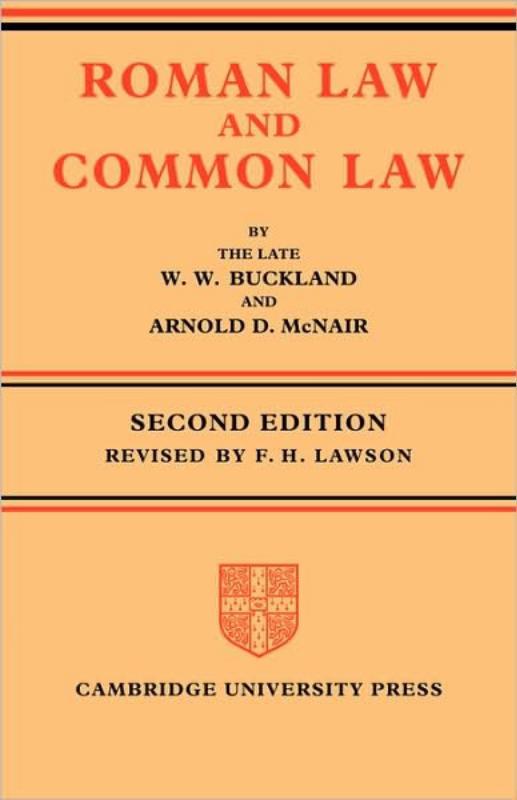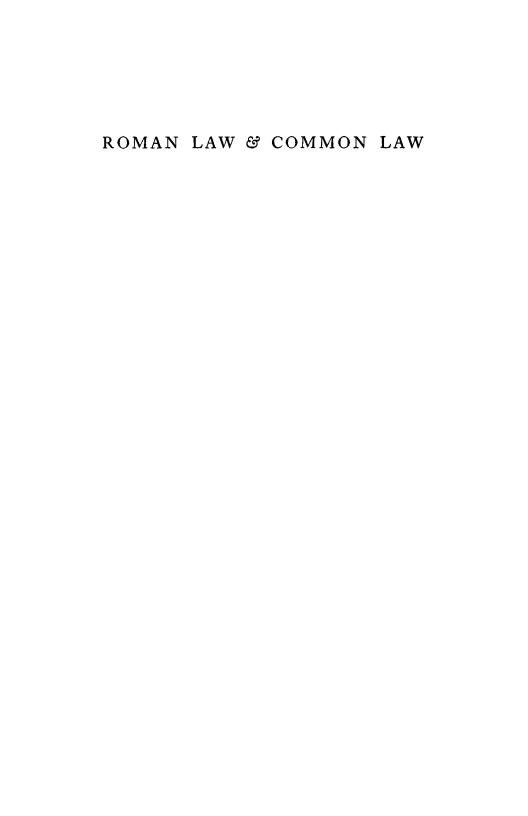
Учебный год 22-23 / W_W_BUCKLAND_AND_ARNOLD_D_McNAIR_ROMAN_LA
.pdf

ROMAN LAW AND COMMON LAW
A COMPARISON IN OUTLINE
BY THE LATE
W.W. BUCKLAND
AND
ARNOLD D. McNAIR
C.B.E., LL.D., Q.C., F.B.A.
Fellow of Gon<ville and Cams College, Cambridge
SECOND EDITION REVISED BY
F. H. LAWSON
D.C.L., F.B.A.
Professor of Comparative Law in the University of Oxford and
Fellow of Brasenose College
CAMBRIDGE UNIVERSITY PRESS
CAMBRIDGE UNIVERSITY PRESS
Cambridge, New York, Melbourne, Madrid, Cape Town, Singapore, Sao Paulo, Delhi
Cambridge University Press
The Edinburgh Building, Cambridge CB2 8RU, UK
Published in the United States of America by Cambridge University Press, New York
www.Cambridge.org
Information on this title: www.cambridge.org/9780521043618
© Cambridge University Press 1936, 1952, 1965
This publication is in copyright. Subject to statutory exception and to the provisions of relevant collective licensing agreements, no reproduction of any part may take place without the written permission of Cambridge University Press.
First published 1936
Second edition 1952
Reprinted with corrections 1965
Reprinted 1974
This digitally printed version 2008
A catalogue recordfor this publication is availablefrom the British Library
ISBN 978-0-521-04361-8 hardback
ISBN 978-0-521-08608-0 paperback
CONTENTS
Preface |
|
|
page ix |
Preface to the Second Edition |
xi |
||
Note on the ig6$ |
Impression |
xiii |
|
Introduction |
|
XV |
|
Abbreviations |
|
xxiii |
|
Chapter I. T H E SOURCES |
1 |
||
I . |
Legislation |
1 |
|
2. |
Case Law |
6 |
|
3. |
Juristic Writings |
1 0 |
|
4. |
Custom |
|
15 |
5. |
General |
Reflexions |
18 |
|
Excursus: Roman and English Methods |
2 1 |
|
Chapter II. T H E LAW OF PERSONS |
23 |
||
1. |
Territorial and Personal Law |
23 |
|
2. |
Slavery |
|
25 |
3. |
Marriage |
3i |
|
4. |
The Family |
38 |
|
5. |
Adoption and Legitimation |
42 |
|
6. |
Minority and Guardianship |
46 |
|
7. |
Juristic |
Personality |
54 |
Chapter III. LAW OF PROPERTY |
60 |
||
1. |
Land and Moveables |
60 |
|
2. |
Property and Possession |
62 |
|
|
Excursus: Property and Possession |
71 |
|
3. |
lura in rem and in personam |
89 |
|
4. |
Ownership in futuro and Terminable Ownership |
91 |
|
5. |
Content of Ownership |
94 |
|
6. |
Trespass |
1 0 2 |
|
7. |
Common Ownership |
103 |
|
8. |
Modes of Conveyance |
n o |
|
9. |
Acquisition by Long Possession |
117 |
|
10. |
Partition |
123 |
|
11. |
Acquisition of Fruits by a Non-owner |
124 |
|
VI |
|
CONTENTS |
|
|
Chapter IV. LIMITED INTERESTS AND SERVITUDES |
page 127 |
|||
Chapter V. UNIVERSAL SUCCESSION |
|
H3 |
||
1. |
Introductory |
|
H3 |
|
2 . |
Heresy Heir, Executor and Administrator |
|
H7 |
|
3. |
Testamentary Form and Capacity |
|
156 |
|
4- |
Soldiers' Wills |
|
158 |
|
5- |
Interpretation |
|
159 |
|
6. |
Freedom of Testation |
|
167 |
|
7- |
Revocation |
|
168 |
|
8. Restrictions as to Remoteness, Unborn |
Bene- |
|
||
|
ficiaries, etc. |
|
173 |
|
9. |
Trusts |
|
176 |
|
1 0 . |
Succession on Intestacy |
|
179 |
|
1 1 . |
The Surviving Spouse |
|
183 |
|
1 2 . |
Succession to Freedmen |
|
186 |
|
i3- |
Bonorum possessio |
|
187 |
|
H- |
Cur a |
prodigi |
|
188 |
i5- |
Dislike of Intestacy |
|
191 |
|
Chapter VI. |
OBLIGATIONS: GENERAL |
|
193 |
|
|
Introductory |
|
||
1. |
|
193 |
||
2. |
Reality of Consent in Contract |
|
196 |
|
|
Excursus: Mistake |
|
205 |
|
3- |
Position of Third Parties |
|
214 |
|
4- |
Agency |
|
217 |
|
5- |
Consideration |
|
2 2 1 |
|
|
Excursus: Cause and Consideration |
|
228 |
|
Chapter VII. |
OBLIGATIONS: GENERAL (cont.) |
|
237 |
|
1. |
Impossibility |
|
237 |
|
2 . |
Casus and Frustration |
|
244 |
|
3- |
Conditions |
|
247 |
|
4- |
Dutyof Third Parties not to interfere with Contract |
257 |
||
5- |
Liability for Non-performance |
|
258 |
|
6. |
Need and Number of Witnesses |
|
263 |
|
7- |
The Relation between the General Law of Con- |
265 |
||
|
tract and the Law of the Particular Contracts |
|||
|
|
CONTENTS |
|
Vll |
Chapter VIII. |
PARTICULAR CONTRACTS |
page 271 |
||
1. |
Unilateral Contracts in General |
|
271 |
|
2. |
Loan for Use, Deposit and Pledge |
|
277 |
|
3. |
Consensual Contracts: General |
|
279 |
|
4. |
Sale |
|
|
280 |
|
Excursus: The Passing of Property and Risk in Sale |
291 |
||
5. Lease of Land and Houses: Letting out of Con- |
|
|||
|
tracts and Services |
|
294 |
|
6. |
Partnership |
|
300 |
|
7. |
Mandatum |
|
307 |
|
8. |
Innominate Contracts |
|
310 |
|
9. |
Joint, and Joint and Several, Obligations |
|
312 |
|
10. |
Security |
|
314 |
|
11. |
Suretyship |
|
324 |
|
Chapter IX. QUASI-CONTRACT AND NEGOTIORUM |
GESTIO |
329 |
||
Chapter X. DELICT AND TORT |
|
338 |
||
1. |
General |
|
338 |
|
2. |
Compensation or Penalty |
|
344 |
|
3. |
Personal Capacity |
|
348 |
|
4. |
Border-line between Contract and Tort |
|
350 |
|
Chapter XI. PARTICULAR DELICTS AND TORTS |
|
352 |
||
1. |
Theft |
|
|
352 |
2. |
Negligence: |
|
362 |
|
|
(a) |
General |
|
362 |
|
|
Excursus: Duty of Care |
|
367 |
|
(b) |
Contributory Negligence |
|
370 |
|
(c) |
Necessity |
|
373 |
|
(d) |
Acts and Omissions |
|
374 |
3. |
Iniuria |
|
378 |
|
4. |
Dolus |
|
|
38 3 |
5. |
Metus |
|
|
390 |
6. |
Calumnia |
|
39l |
|
7. |
Nuisance |
|
392 |
|
8. |
Quasi-delict |
|
395 |
|
Vlll |
CONTENTS |
|
Chapter XII. PROCEDURE |
page 399 |
|
1. |
Substantive and Procedural Law |
399 |
2. |
Consent of the Parties. Arbitral |
Origin of |
|
Roman Procedure |
400 |
3. |
Oaths |
404 |
4. |
Discovery of Facts and Documents |
405 |
5. |
Representation in Litigation |
407 |
6. |
Forms of Action |
409 |
7. |
Contracts of Record |
41 o |
8. |
Appeals |
411 |
9. |
Judgement |
412 |
1 o. |
Prescription: Limitation and Abatement of Actions 413 |
|
11. |
Delay in securing Judgement |
419 |
12. |
Interdicts and Injunctions |
420 |
Index |
|
425 |
PREFACE
It will be convenient to state what this book is and what it is not. It is far from being a comprehensive statement of Roman law and common law comparatively treated. It is rather a comparison of some of the leading rules and institutions of the two systems. One of us many years ago produced a small book entitled Equity in Roman Law* the aim of which was to show the way in which the Roman lawyer worked. The institutions with which he dealt were subordinated to the way in which he worked on them, and an attempt was made to show that, working on institutions often very differently shaped, he handled them in ways very similar to those of English lawyers and reached results, especially in the field covered by modern English equity, astonishingly like theirs. In this book, on the other hand, it is the rules and institutions themselves that are compared. These are no doubt to some extent the work of the lawyers, but that is not true of the most basic notions: these were formed in their essentials long before there was such a thing as the professional study of law. They may be regarded as given, as not being the lawyers' work but the materials on which they worked, moulded however into the form in which we know them from the sources by many generations of lawyers and, no doubt, politicians.
Least of all does this book attempt to estimate the influence of Roman law upon English law, as has been done by the late Lord Justice Scrutton in his Yorke Prize Essay, by Dr Oliver in Cambridge Legal Essays and by Professor Mackintosh in his Roman Law in Modern Prac-
1 By W. W. Buckland, published in 1911 by the University of London Press, which has been kind enough to allow us to use parts of the book in the preparation of this volume.
